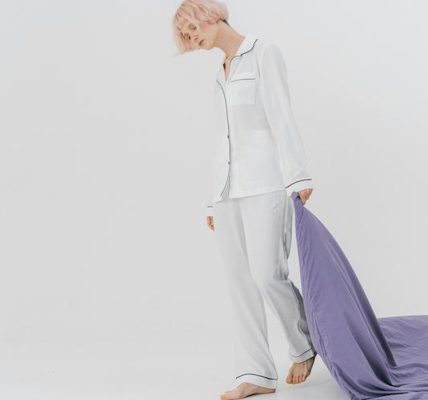Footie pajamas have long been a beloved staple in sleepwear, especially for children. These cozy garments combine comfort and warmth, making them ideal for chilly nights. However, as children grow and their needs change, parents often wonder when it’s appropriate to stop using footie pajamas. This article explores the signs that indicate it might be time to transition to different sleepwear, helping you make an informed decision for your child.
The Appeal of Footie Pajamas
1. Comfort and Warmth
When to stop using footie pajamas? One of the main reasons parents opt for footie pajamas is the incredible comfort they provide. Made from soft fabrics like cotton or fleece, these pajamas envelop the body, offering warmth during colder months. The footed design ensures that little feet stay toasty without the need for socks, which can easily be kicked off during sleep.
Benefits of Comfort:
- Keeps children warm
- Soft materials promote better sleep
- Reduces nighttime awakenings due to cold
2. Safety and Security
Footie pajamas also provide a sense of security for many children. The snug fit and full coverage can help prevent drafts and make kids feel more secure while sleeping. This can be especially important for younger children who may be more sensitive to changes in their environment.
Key Safety Features:
- Full-body coverage
- Reduced risk of getting cold at night
- Less chance of entanglement in sheets
Signs It’s Time to Transition
1. Physical Growth
Children grow rapidly, and one of the most evident signs that it’s time to stop using footie pajamas is when they start to outgrow them. If your child’s feet are crammed into the footed sections or the pajamas appear too tight around the torso, it’s definitely time for a change. Ill-fitting pajamas can disrupt sleep and lead to discomfort.
Growth Indicators:
- Tightness in foot areas
- Pajamas riding up during sleep
- General signs of discomfort
2. Increased Independence
As children reach certain developmental milestones, they often express a desire for independence, including choices in their clothing. If your child shows interest in picking out their own pajamas or prefers more grown-up styles, it may be a good opportunity to transition away from footie pajamas.

Signs of Independence:
- Choosing sleepwear styles
- Expressing discomfort with current pajamas
- Asking for “big kid” clothing
3. Temperature Preferences
Kids can have varying temperature preferences. As they grow, they may become more sensitive to warmth and start to prefer lighter sleepwear. If your child frequently complains about being too warm in footie pajamas or kicks off the top portion during the night, it’s a clear signal that a change is needed.
Temperature Sensitivity Indicators:
- Frequent complaints of overheating
- Kicking off pajamas during sleep
- Preference for lighter fabrics
Alternatives to Footie Pajamas
1. Two-Piece Pajama Sets
When to stop using footie pajamas? Two-piece pajama sets are a popular alternative as they offer flexibility and comfort. They typically consist of a top and bottom, allowing for easier movement and temperature control. Look for sets made from breathable materials like cotton to ensure a comfortable night’s sleep.
Benefits of Two-Piece Sets:
- Easier to dress and undress
- Variety of styles and patterns
- Adjustable to temperature needs
2. Sleep Dresses or Nightgowns
For young girls, sleep dresses or nightgowns can be a charming alternative to footie pajamas. These garments provide freedom of movement while still offering comfort. Choose options made from soft, breathable materials to keep your child cool and cozy.
Advantages of Sleep Dresses:
- Easy to wear and stylish
- Available in various lengths
- Often more breathable than footed options
3. Shorts and T-Shirt Sets
As summer approaches, shorts and t-shirt sets become a practical choice. These allow for better airflow and can keep children cool during warmer nights. Look for options that are easy to put on and take off, ensuring your child can maintain their independence.
Benefits of Shorts and T-Shirt Sets:
- Great for warmer weather
- Easy to mix and match
- Promotes independence in choosing outfits
Tips for Transitioning Away from Footie Pajamas
1. Involve Your Child in the Process
When it’s time to transition, involve your child in the decision-making process. Let them choose their new sleepwear from a selection of options. This can help ease any anxiety about the change and make them feel excited about their new pajamas.
2. Gradual Transition
If your child is particularly attached to their footie pajamas, consider a gradual transition. Start by introducing two-piece sets while still allowing them to wear footie pajamas on colder nights. Over time, you can phase out the footed options entirely.
3. Create a Comfortable Sleep Environment
Ensure your child’s sleep environment is comfortable. Adjust bedding, room temperature, and lighting to help them settle into their new sleepwear. A cozy, inviting space can make the transition smoother.
The Emotional Attachment to Footie Pajamas
1. Comfort Objects and Sleep Associations
Children often develop emotional attachments to certain items, including footie pajamas. These garments can become comfort objects that symbolize safety and warmth. It’s important to recognize this emotional connection, as transitioning away from them can be an adjustment.
2. Making the Transition Easier
To ease the transition, consider introducing a special new sleep item, such as a cozy blanket or a stuffed animal. This can provide your child with a new comfort object, making it easier to move on from their beloved footie pajamas.
3. Creating New Sleep Rituals
Incorporate new bedtime rituals that promote relaxation and comfort. Reading a favorite story, playing calming music, or practicing deep breathing exercises can help establish a positive association with the new sleepwear. Creating a new routine can also shift the focus from the pajamas to the overall bedtime experience.
Additional Tips for Selecting Sleepwear
1. Consider Seasonal Changes
As seasons shift, so do sleepwear needs. In winter, opt for thicker fabrics like fleece, while lighter cottons are perfect for summer. Keep an eye on the forecast and adjust your child’s sleepwear accordingly. Layering is also a great option for fluctuating temperatures, allowing for added warmth without bulk.

2. Check for Ease of Use
Look for sleepwear that is easy for your child to put on and take off. Features like elastic waistbands, simple buttons, or zippers can make a significant difference in promoting independence. The easier it is for them to manage their sleepwear, the more likely they are to embrace the change.
3. Opt for Quality Over Quantity
Investing in high-quality sleepwear will pay off in the long run. Durable fabrics can withstand frequent washing and wear, ensuring that the pajamas last longer. While it may be tempting to purchase multiple inexpensive sets, quality sleepwear will provide better comfort and longevity.
Understanding Your Child’s Sleep Needs
1. Age and Developmental Stages
As your child grows, their sleep needs change. Younger children often require more sleep than older kids and may benefit from cozier sleepwear to help them settle down. In contrast, older children may prefer more freedom of movement and less restrictive clothing as they approach adolescence.
2. Individual Sleep Preferences
Every child is unique. Some may thrive in cozy, enclosed sleepwear, while others might feel constricted and uncomfortable. Pay attention to your child’s reactions to different styles and adjust accordingly. Their comfort should always be a priority.

3. Monitoring Sleep Quality
Transitioning from footie pajamas can impact your child’s sleep quality. Monitor how they adapt to new sleepwear and whether they experience changes in their sleeping patterns. If they seem restless, it might be time to reassess the sleepwear options and consider alternatives that better suit their needs.
Conclusion
Footie pajamas serve a vital purpose in keeping children warm and comfortable during sleep. However, recognizing when to stop using them is equally important for your child’s comfort and development. By observing growth, independence, and temperature preferences, you can make an informed decision about transitioning to new sleepwear. Embrace the change by exploring alternatives that maintain comfort while promoting your child’s individuality.




